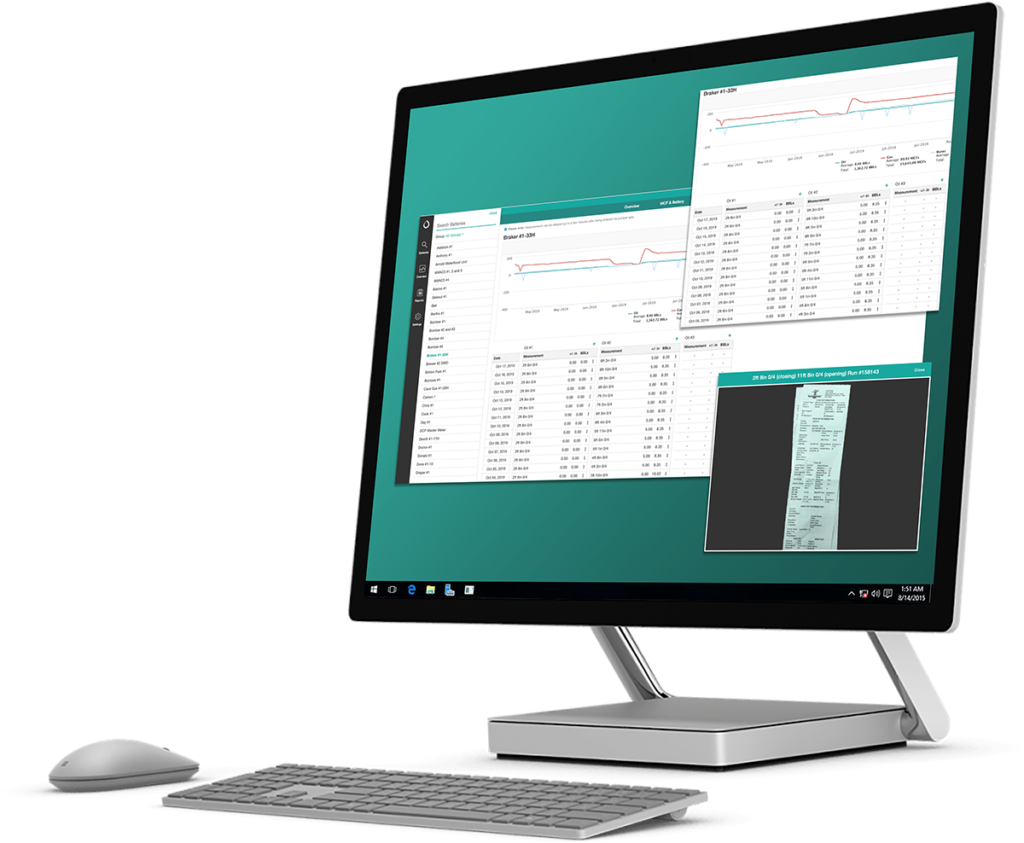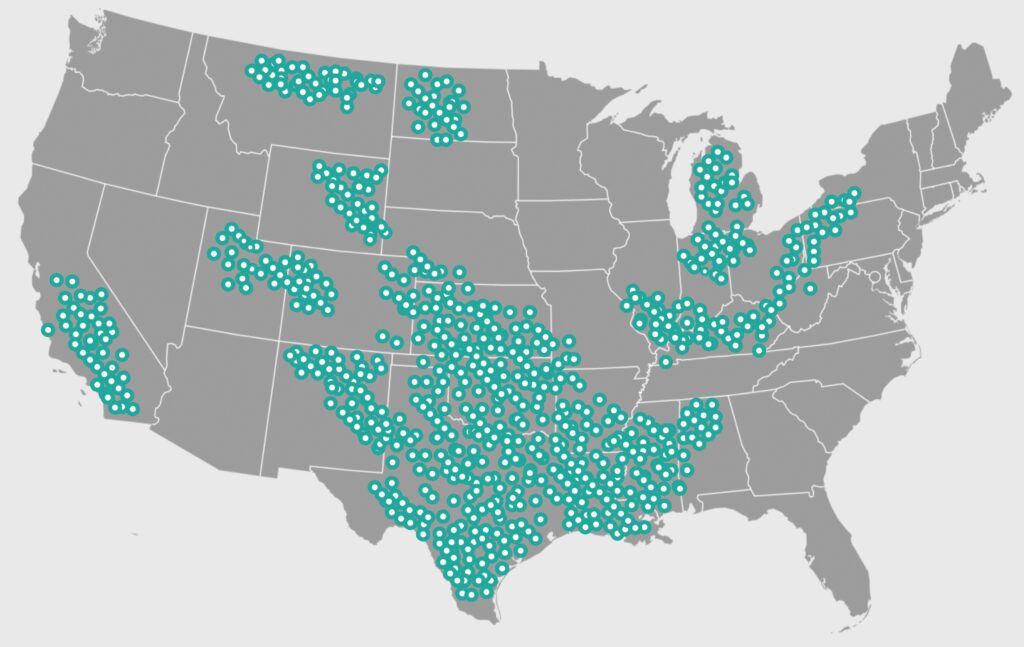Tests of all different sorts are a regular part of running a lease pumping operation. Regular testing of a well using different oil and gas well testing procedures is the only way to discover important information, which will be necessary to making decisions about production as well as determining production allocation.
Some oil and gas well testing can be quite specialized, but there are a few that you’ll almost certainly have to conduct. Well testing is ultimately about the behavior of the reservoir it draws from, so it might be helpful to understand something about how reservoir pressure works.

The Basics Of Reservoir Pressure
The reservoirs that are pumping wells draw from are under some amount of pressure. That pressure is essential to the processing of extracting oil from reservoirs, and in some cases is enough to push oil to the surface as soon as the reservoir is tapped. In most cases, the pressure is low enough that some artificial lift is needed to bring oil to the surface; that lift is provided by a pump. Pressure is still required to push new fluid to the bottom of the hole as it is pumped out. Pressure declines as fluid is drawn from the reservoir, eventually to the point where it’s no longer possible to produce oil from the reservoir.
The pressure can be the result of a few different natural processes. Many wells will be driven by gas, having either a gas solution drive or a gas cap drive. In either case, the gas is contained under pressure within the reservoir so that oil is pushed to the surface. With gas solution drive, the gas is dissolved into the fluid. The gas will break out of the fluid as it is pumped to the surface. With gas cap driven reservoirs, the gas sits on top of the fluid.
Water can also provide the pressure that powers the well. As oil and gas are drawn from a reservoir, water may flow into the newly empty space, helping to maintain the reservoir’s pressure. As oil is removed, the level of water will rise, so the tubing perforations will have to be regularly raised to keep pace with the oil. Otherwise, the amount of water you’re pumping will increase until that’s all you’re pumping out. Injecting water back into a formation is a popular technique for maintaining pressure in a reservoir as oil is pumped out.
In some cases, the pressure may be provided just by the force of gravity, the weight of the oil itself forcing it down to the wellbore. With a gravity drainage reservoir, the oil level will fall as oil is pumped out, so the perforations will need to be lowered gradually over the life of the well.
Tests
Each test is designed to reveal specific information about a well. To get a full understanding of how a well is behaving, it may be necessary to run a range of oil well testing procedures and examine the results over a period of time. The tests listed here are run as a standard part of operating a well or bringing a well into operation.
Potential
The potential test is designed to measure a well’s production potential for a single day. It’s a test that’s run on new wells or on wells that have been worked over. Before a potential test can be performed, the well has to be prepared by shutting it in until it reaches its maximum pressure. The standard shutting in period is 24 hours, but can vary depending on the well.
The potential production of a well is obviously a handy piece of information and you’ll want to note it in your well tests sheet. For a new well, the potential will be helpful in deciding whether the well will be profitable (meaning turning a profit while producing) and if it will pay out (meaning it will generate enough profit over the life of the well to pay for the expense of exploiting it). It can also give you a good idea if there may be a maximum allowable production for that well, which will be set by a regulating agency. The potential production will also inform the design of the tank battery, whether offset wells should be drilled, and whether it’s worth it to collect and sell gas produced from the well.
If the well isn’t new, but instead has just been worked over, potential tests are used for slightly different purposes. Primarily, it will tell you whether the work over had the intended effect, solving problems or increasing production. It will also tell you whether the work over was worth it, meaning the well will generate enough additional production to pay the cost of working it over. The potential of one worked over well can also help you decide if it’s worth it to work over other wells nearby.
Daily Production
As the name implies, a daily production test measures the standard production of a well in one 24 hour period. It measures the gas, water, and oil when the well is working normally, which is helpful for tracking the well’s production over the long term. It can also be helpful in identifying problems, but the real strength of the daily production test is showing how the behavior of a well changes over time. The well needs to be running without any problems, reductions, or interruptions for at least 24 hours before the start of the test. This process is called normalizing, and is important for getting an accurate measurement of the well’s true standard daily production.
It’s a good idea (and usually required) to run a daily production test at least once a month. Ideally, it should be done on the same date of each month. The results of the test should be recorded in a record book with a separate section for each well. And, although many pumpers use a log sheet with 12 rows and enough columns to record all the results for these tests, due to the proliferation of smartphones many are switching to mobile apps like the GreaseBook to help track these tests. The app allow all the results from a year’s worth of daily production tests to be laid out in one spot where they can be easily seen and compared, and even stands in for a cost-effective oil and gas production allocation software.
The results of these tests are very useful, and can help you find and repair problems, anticipate the lifespan of pumps and other equipment, and estimate production and plan ahead. Without a reliable record of past production, everything essentially comes down to guesswork and intuition, which is not a great way to operate a profitable well.
When a tank battery only receives production from one well, it can be tempting to simply use the average daily production from over the course of the month, rather than performing a daily test. The problem with that oil and gas production allocation method is that the average will include any downtime for repairs or maintenance, problems downhole that may have affected production, or any other loss. The daily production numbers based on this average will be lower than the true standard daily production. It’s also difficult to measure the amount of time and production that has been lost to repairs and other problems when taking the average, which can make decisions regarding the well’s operations more difficult.
Finally, we go into more depth on the set-up and recording of daily tests in the GreaseBook here: The Basics Of Keeping Records For Oil & Gas Production, here Operational Records For Oil & Gas Production Wells, and here Well Records For Oil & Gas Production.
Gas-to-Oil Ratio
This test, as you might guess, measures the ratio of gas to oil produced from the well. The results of these sorts of tests are usually forwarded to some sort of regulatory agency, which will track the amount of gas produced and potentially set limits on the maximum amount of gas an operation is allowed to produce from the well over a given span of time. The well will need to be shut in for about 24 hours before the test is run.
Limits on oil production are usually higher than the well can produce, so they are rarely a barrier. Limits on gas production can be more strict, but it is for a good reason. As mentioned above, reservoirs have to be under pressure for oil to be drawn from a well. Even when the well is not tapping a gas drive reservoir, natural gas will usually exert some amount of pressure. Drawing too much gas from the reservoir will lower the pressure, with the result that the well’s production drops or even stops altogether.
Reservoirs are almost always large enough that several different companies may have wells drawing from it. While Company A may have measures in place to manage gas production and so extend the life of the well, Company B may simply decide to produce all the gas possible from the well. Company B’s decision to over-produce gas will have an effect on Company A and any other companies with wells in the same reservoir, possibly reducing the production potential by years. An allowable production rate actually ensures that every pumper is operating responsibly. In many cases, it’s possible for one company to take over managing most or all of the wells in a particular area or reservoir. That company can then manage the whole field for the maximum return and efficiency, sharing the resulting profits with the other operations. This process is called unitizing a field.
Productivity
The idea of a productivity test is to produce the well in a couple different ways, with the goal of discovering the most efficient way of pumping oil for that particular well. Running productivity tests on a regular basis is important, as the well will change over time and adjusting your operations to match it is going to be necessary at some point. The test may take a number of days, as it may take a short while after a change is made before production settles down to a consistent rate. The well should be normalized by running it without problems or interruptions for at least 24 hours before the test.
A productivity test will usually begin by pumping the bottom of the well clear of fluid. The pump should then be shut in so that the well bottom can fill with fluid once more. Ideally, you’ll want to monitor and measure the rate at which the fluid seeps back into the bottom of the well. Some pumpers can get a good idea of the time required just by understanding the characteristics of the well and reservoir, and by drawing on experience. Getting an accurate, specific measurement will require an echometer and dynamometer. The echometer uses a process somewhat similar to SONAR to measure the fluid level in the well. A dynamometer is helpful in measuring the action of the pump, which can have an affect on the volumes produced as well. Once fluid has flowed back into the bottom of the well, the pump can be activated and the echometer used again to measure how quickly the pump draws the fluid level down.
An echometer and dynamometer are both expensive and delicate pieces of equipment, and it’s possible that you may not want to spring for one, or the operator you work for won’t want to. Oil was pumped out of the ground for many years before those two measuring instruments were invented, so it’s certainly possible to run a successfully operation without them. However, the more information that is available to you, the more likely you are to make a good and profitable decision.
There are some productivity tests that can be performed without a great deal of special equipment. Essentially, this boils down to making small changes gradually to see how they affect production.
Some information can also be gathered just by paying attention and understanding what’s happening. For example, you can take two fingers and lightly pinch the rod so that you can feel the action of the pump. You’ll be able to feel the difference between a pump pushing liquid and a pump hitting bottom. A cool rod means the well is pumping properly, while a warm rod can mean there is a problem. Other workarounds are also possible.
A wide range of factors can have an effect on a well’s operation and the best way to produce it. Factors can include the reservoir’s drive, the porosity of the formation, the weight of the oil and percentage of paraffin, and the potential for scale and corrosion. Some wells will produce more if pumps are run intermittently, which allows fluid and pressure to build up at the bottom of the well when the pump is shut in. Likewise, a smaller pump won’t pump as fast. The frequency and length of the strokes on the pumping unit, backpressure in the flow line, and the depth and setting of perforations can also affect production, and can be adjusted during productivity tests.
Other Regular Tests
Shorter or less complex versions of these tests can be run if there’s a specific problem and you’re looking for the cause. Troubleshooting and diagnosing problems is going to be a big part of a pumper’s duties, so it’s a good idea to get familiar with the equipment and how to test if it’s working correctly.
Barrel tests are an example of a quick test that can be run to look for specific problems. For example, if there’s a drop in production but several wells are producing to the same tank battery, it can be difficult to even figure out which well is having the problem, let alone the cause. Running a daily production test on each well can take days or weeks, and during all that time production is less than it could be.
Barrel (or bucket) tests are usually performed by taking a small sample through the bleeder valve at the wellhead. The barrel or bucket should be of a known volume. You can then measure the amount of time it takes to fill that barrel. A simple formula can be used to determine how many barrels per day is produced at that flow rate.
A problem with drawing oil from the bleeder valve is that it may cause a drop in pressure in the flow line. This can cause gas to break out of the fluid, which can throw the results of the test off. Installing a valve to maintain backpressure on the bleeder valve addresses that issue.
Is your appetite for oil & gas operating knowledge insatiable like ours? 😀 If so, check out these related articles: How To Test Wells In Oil & Gas Production, Special Tests for Flowing Wells in Oil and Gas Production and, Pressure Gauges In Oil & Gas Production – they’ll be sure to pump you up!!!








